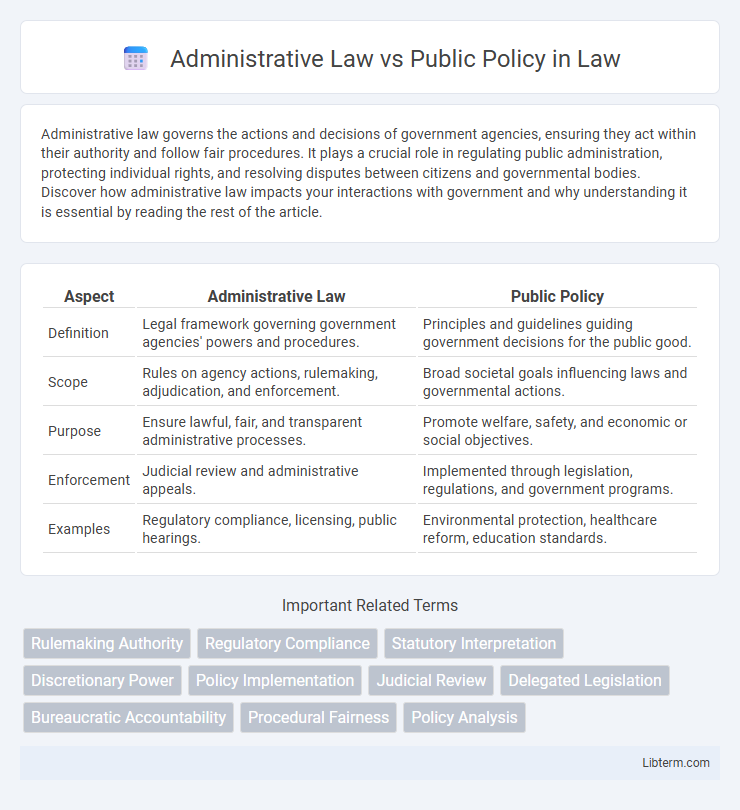Administrative law governs the actions and decisions of government agencies, ensuring they act within their authority and follow fair procedures. It plays a crucial role in regulating public administration, protecting individual rights, and resolving disputes between citizens and governmental bodies. Discover how administrative law impacts your interactions with government and why understanding it is essential by reading the rest of the article.
Table of Comparison
| Aspect | Administrative Law | Public Policy |
|---|---|---|
| Definition | Legal framework governing government agencies' powers and procedures. | Principles and guidelines guiding government decisions for the public good. |
| Scope | Rules on agency actions, rulemaking, adjudication, and enforcement. | Broad societal goals influencing laws and governmental actions. |
| Purpose | Ensure lawful, fair, and transparent administrative processes. | Promote welfare, safety, and economic or social objectives. |
| Enforcement | Judicial review and administrative appeals. | Implemented through legislation, regulations, and government programs. |
| Examples | Regulatory compliance, licensing, public hearings. | Environmental protection, healthcare reform, education standards. |
Introduction to Administrative Law and Public Policy
Administrative law governs the activities of government agencies, ensuring lawful decision-making and procedural fairness. Public policy consists of the principles and actions adopted by government to address societal issues, shaping regulations and administrative practices. Understanding the intersection of administrative law and public policy highlights how legal frameworks support effective governance and policy implementation.
Defining Administrative Law
Administrative law governs the activities of governmental agencies, ensuring they act within their legal authority while implementing public policies. This branch of law defines the procedures for rulemaking, adjudication, and enforcement, providing checks and balances on administrative actions. Understanding administrative law is crucial for interpreting how public agencies create and enforce regulations that shape public policy.
Understanding Public Policy
Public policy represents the principles and guidelines that govern societal decisions and government actions to achieve collective goals. It shapes administrative law by directing how government agencies create rules, enforce regulations, and implement programs. Understanding public policy is essential for interpreting the legal framework that supports regulatory decisions and ensures accountability in public administration.
Key Differences Between Administrative Law and Public Policy
Administrative law governs the rules and procedures of government agencies, ensuring lawful and fair decision-making processes, while public policy refers to the broader principles and goals guiding government actions and legislation. Administrative law involves legal frameworks, judicial review, and enforcement mechanisms, whereas public policy shapes societal priorities through legislation, regulations, and public initiatives. The key difference lies in administrative law's focus on legal control of agencies versus public policy's emphasis on value-driven objectives and outcomes.
Overlapping Areas in Administrative Law and Public Policy
Administrative law and public policy overlap significantly in regulatory decision-making, where administrative agencies implement policies through rulemaking and enforcement actions. Both fields address the delegation of governmental authority, ensuring that administrative actions align with statutory mandates and public interests. Judicial review serves as a critical mechanism to evaluate whether administrative decisions conform to established public policy objectives and legal standards.
Role of Government Agencies
Government agencies play a critical role in administrative law by implementing and enforcing regulations that ensure compliance with statutory mandates. These agencies interpret legislative intent and create rules that directly impact public policy outcomes, shaping social and economic frameworks. Their decisions and actions influence governance efficiency, public accountability, and the protection of citizens' rights within the scope of regulatory authority.
Legal Framework Shaping Public Policy
Administrative law establishes the legal framework that governs public agencies' powers and responsibilities, ensuring public policy implementation adheres to statutory mandates and constitutional principles. It provides mechanisms for accountability, transparency, and judicial review, allowing courts to oversee agency decisions impacting public welfare. This interplay between administrative law and public policy shapes effective governance by balancing regulatory authority with citizens' rights and public interests.
Policy Implementation through Administrative Law
Administrative law serves as the framework through which public policies are implemented, ensuring regulatory compliance and accountability within government agencies. It provides the legal mechanisms for enforcement, adjudication, and rule-making, transforming legislative intent into actionable programs. Effective policy implementation relies on administrative law to clarify authority, resolve disputes, and maintain transparency in executing public objectives.
Impact on Citizens and Society
Administrative law establishes the legal framework for government agencies' actions, ensuring decisions are transparent, accountable, and subject to judicial review, which protects citizens' rights and promotes fairness. Public policy shapes societal priorities and resource allocation, directly influencing quality of life, social justice, and economic development. The interplay between administrative law and public policy determines how effectively government interventions address public needs and safeguard democratic principles.
Future Trends in Administrative Law and Public Policy
Future trends in administrative law emphasize the integration of digital governance technologies, enhancing transparency and efficiency in public policy implementation. Advances in artificial intelligence and big data analytics are reshaping regulatory frameworks to enable adaptive, evidence-based decision-making processes. Increased public participation facilitated by digital platforms promises to democratize policy formation and strengthen governmental accountability.
Administrative Law Infographic

 libterm.com
libterm.com